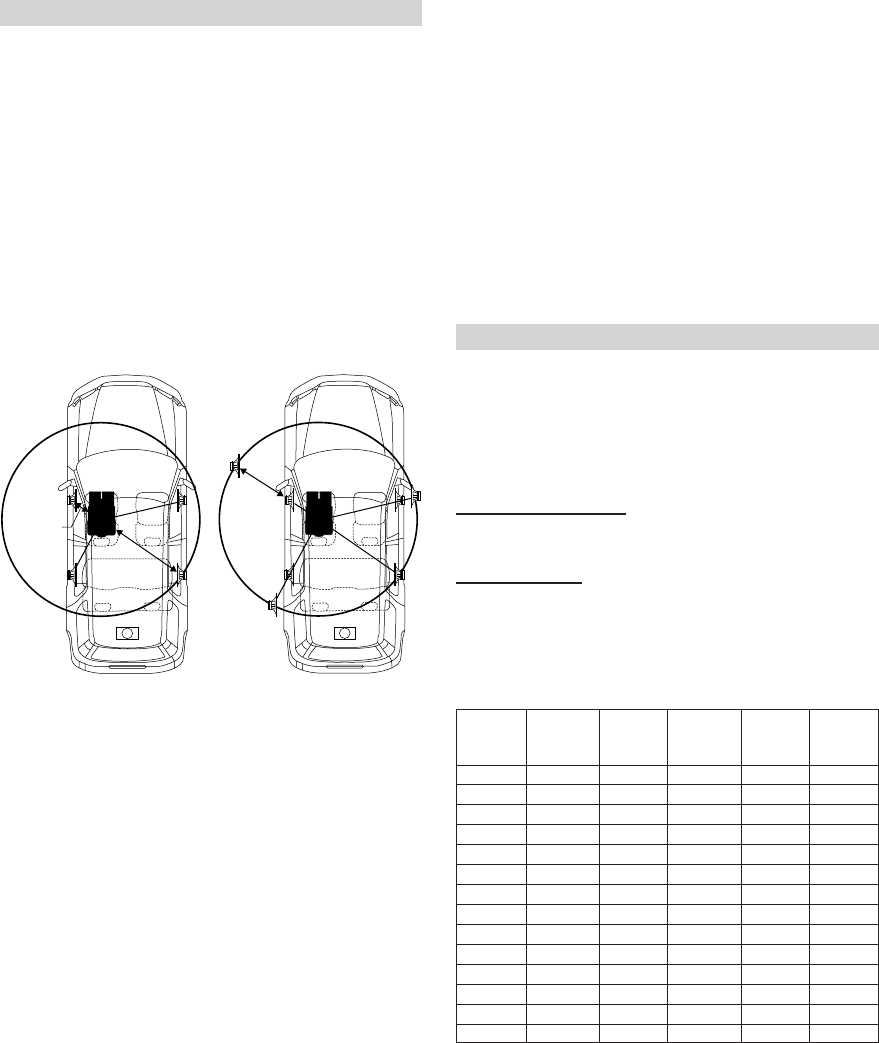
22-EN
Time Difference Table
0 0.0 14 1.4 28 2.8
1 0.1 15 1.5 29 2.9
2 0.2 16 1.6 30 3.0
3 0.3 17 1.7 31 3.1
4 0.4 18 1.8 32 3.2
5 0.5 19 1.9 33 3.3
6 0.6 20 2.0 34 3.4
7 0.7 21 2.1 35 3.5
8 0.8 22 2.2 36 3.6
9 0.9 23 2.3 37 3.7
10 1.0 24 2.4 38 3.8
11 1.1 25 2.5 39 3.9
12 1.2 26 2.6 40 - 98 4.0 - 9.8
13 1.3 27 2.7 99 9.9
Number
of Steps
Time
Difference
(ms)
Number of
Steps
Time
Difference
(ms)
Number of
Steps
Time
Difference
(ms)
Example 2. Listening Position: All Seats
Adjust the time correction level of each speaker to almost the
same level.
1
Sit in the listening position (driver’s seat, etc.) and
measure the distance (in meters) between your
head and the various speakers.
2
Calculate the difference between the distance to
the farthest speaker and the other speakers.
L = (distance to farthest speaker) – (distance to other
speakers)
3
Divide the distances calculated for the speakers by
the speed of sound (343 m/s (765 mph) at 20˚C).
These values are the time correction values for the
different speakers.
Bass Focus
Setting item: BASS FOCUS
Setting contents: TIME DN / UP / FRONT / LEFT / RIGHT /
REAR
The time difference between the front-rear/left-right speakers, can be
adjusted at the same time. With an initial delay of 0.1 ms for each of
the 0 to 99 steps, audible time correction can be done.
Selecting the speaker:
Select the speaker among 3 (FRONT) through 6 (REAR).
Setting the step:
Press 1 (TIME ;DN) or 2 (TIME UP:) to set the step.
• Any manual time correction adjustments will also affect
corrections made for bass focus.
About the Time Correction
The distance between the listener and the speakers in a car vary
widely due to the special conditions of the mobile environment. This
difference in the distances from the speakers to the listener creates a
shift in the sounds image and frequency characteristics. This is caused
by the time delay between the sound reaching the listener’s right
versus left ear.
To correct this, the IVA-D901 is able to delay the audio signal to the
speakers closest to the listener. This effectively creates a perception of
increased distance for those speakers. The listener can be placed at an
equal distance between the left and right speakers for optimum
staging.
The adjustment will be made for each speaker in a step of 0.1 ms.
Example 1. Listening Position: Front Left Seat
Adjust the time correction level of the front left speaker to a
high value and the rear right to zero or a low value.
Tips
*
Subwoofer speaker
You cannot change the time correction value for the
subwoofer, but you can set the subwoofer's apparent position
to the front by adjusting the time correction value of the front
and rear speakers.
For details, refer to the “Tips” on page 23.
Here we calculate the time correction value for the front left
speaker in the diagram above.
Conditions:
Farthest Speaker – listening position: 2.25 m (88-9/16")
Front left speaker – listening position: 0.5 m (19-11/16")
Calculation: L = 2.25 m – 0.5 m = 1.75 m (68-7/8")
Time correction = 1.75 ÷ 343** × 1000 = 5.1 (ms)
** Speed of sound: 343 m/s (765 mph) at 20˚C
The sound is not balanced because the distance between the
listening position and the various speakers is different.
The difference in distance between the front left speaker and
the rear right speaker is 1.75 m (68-7/8").
Time correction eliminates the differences in the time required
for the sound to reach the listening position.
The time of the front left speaker is corrected by 5.1 ms so that
its sound reaches the listening position at the same time as the
sound of other speakers.
In other words, giving the front left speaker a time correction
value of 5.1 ms makes it seem as if the distance to the front left
speaker is the same as the distance to the farthest speaker.
2.25m
0.5m
∗
5.1ms
∗


















